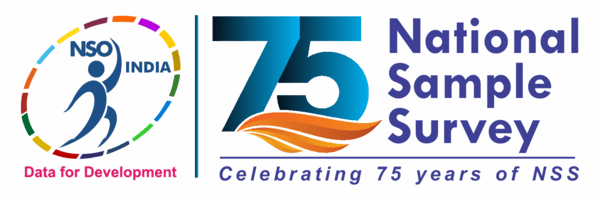DDI-IND-MOSPI-NSSO-HCES22-23
Household Consumption Expenditure Survey: 2022-23
| Name |
|---|
| INDIA |
The National Sample Surveys (NSS) are being conducted by the Government of India since 1950 to collect socio-economic data employing scientific sampling methods. Household Consumption Expenditure Survey 2022-23 will commence from July 2022.
Information collected in the survey will be primarily used for preparation of weighting diagram through determination of budget shares of different commodity groups in total consumption for compilation of consumer price indices for rural and urban India. In addition,
statistical indicators of level of living, social consumption and well-being, and inequalities therein will also be compiled from the data collected in the survey.
The survey will cover the whole of the Indian Union except the villages in Andaman and Nicobar Islands which are difficult to access.
Total 15016 FSUs will be surveyed for the central sample at all-India level.
| Name | Affiliation |
|---|---|
| NSSO | MoSPI |
| Name | Affiliation |
|---|---|
| COMPUTER CENTRE | M/o STATISTICS & PROGRAMME IMPLEMENTATION |
| Name |
|---|
| M/o STATISTICS & PROGRAMME IMPLEMENTATION |
In this survey, a different methodology will be used for determining the consumption and expenditure of a household on different items. The complete set of information on consumption will be collected through three different questionnaires (FDQ, CSQ and DGQ)
canvassed at different time points to a sample household. Apart from these three questionnaires, another questionnaire on household characteristics (HCQ) will also be canvassed in a household. The sample households will be visited three times - in the first
visit, listing of households will be done, sample households will be selected, Questionnaire on Household Characteristic (HCQ) and another Questionnaire (out of other three Questionnaires on consumption) will be canvassed. In the next two months, other two
Questionnaires will be completed from the same household. Equal number of sample FSUs will be selected in a month. Thus it will be a panel survey for a short duration where each sample FSU and each sample household will be retained for a period of three months.
Although all three questionnaires on consumption will be canvassed to all selected households, sequence of questionnaire to be canvassed is also important since a suitable randomization will eliminate any bias due to any particular sequencing of questionnaire.
Thus, all possible sequencing of questionnaires [(Q1, Q2, Q3), (Q1, Q3, Q2), (Q2, Q1, Q3), (Q2, Q3, Q1), (Q3, Q1, Q2) and (Q3, Q2, Q1)], where Q1 refers to FDQ, Q2 refers to CSQ and Q3 refers to DGQ, are desirable in the sample of households. If a sample household is found to be temporarily locked in second visit, the JSO/SE would visit the locked household any time later during the same month for canvassing the questionnaire. If the household is found to be locked during the entire month of second visit, the second and third visit questionnaires will be canvassed together at the time of third visit.
Number of sample households per FSU and minimum number of FSUs perstratum:
18 sample households will be canvassed within an FSU in the following manner:
Distribution of 18 sample households per FSU:
Sample households will be distributed in a manner to have all combinations of three questionnaires. Three sequences of uestionnaires can be canvassed in each FSU. Annual number of sample FSUs may be selected in the form of 10 Panels with 2 Sub-samples in each
panel. One panel will be of three months duration and in each sub-sample three particular sequences of questionnaires will be allotted so that all six sequences are accommodated in 2 sub-samples of each panel. The Panel 10 will start in the month 10 and will be completed in month 12.
An illustration for determination of canvassing sequence of the households belonging to different SSS with three different allocation scenarios leading to a total of 18 households is given in Section 1.4.19. If total no of listed households for a particular FSU is less than 18 then more or less equal number of households will be canvassed in each sequence.
The number of sample FSUs per stratum will be a minimum of 20 for each of rural/urban sector separately.
Allocation of total sample to State/UTs: The total number of sample FSUs will be allocated to the State/UTs in proportion to population as per Census 2011 subject to a minimum sample allocation of 40 FSUs to each State/UT in general Allocation of State/UT level sample to rural and urban sectors: State/UT level sample size will be allocated between two sectors in proportion to population as per Census 2011 with 1.5 weightage to urban sector. A minimum of 20 FSUs, each for rural and urban sector separately, will be allocated to each State/UT. For more urbanised big States like Maharashtra, Tamil Nadu etc., the urban allocation will be limited to rural sample size to avoid undue weightage to urban sector.
Allocation to strata: Within each sector of a State/ UT, the respective sample size will be allocated to the different strata in proportion to the population as per Census 2011. Stratum level allocation will be adjusted to multiples of 20 with a minimum sample size of 20.
For special stratum formed at all-India level, 20 FSUs will be allocated.
Allocation to sub-strata:
Generally, allocation will be 20 for each sub-stratum in the rural/urban sector. However, allocation will be adjusted in case of constraints of sample size. Thus, allocations may be more than 20 in some cases, especially in case of smaller States/UT and States of North Eastern Region.
DDI-IND-MOSPI-NSSO-HCES22-23
| Name | Affiliation | Role |
|---|---|---|
| COMPUTER CENTRE | M/o STATISTICS & PROGRAMME IMPLEMENTATION | DOCUMENTATION OF THE STUDY |

